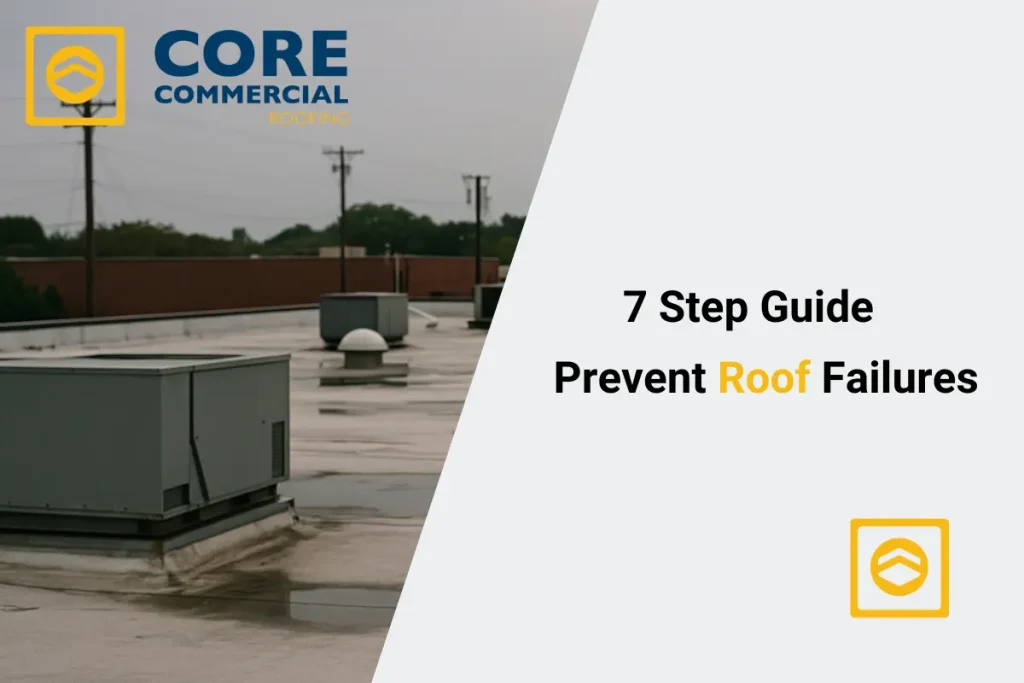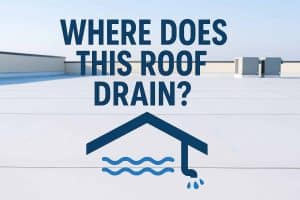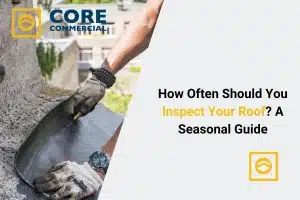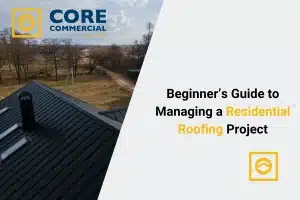Roof failures in Texas aren’t just annoying—they’re expensive, disruptive, and completely avoidable. With intense sun, sudden hailstorms, strong winds, and heavy rain, commercial buildings across Texas face serious roof stress year-round. But here’s the truth: most major roof issues start with something small. One of the smartest long-term solutions is installing a proper drainage system. When water has nowhere to go, damage follows fast. Drainage upgrades are often overlooked, but they’re one of the most effective defenses against roof failure.
This article breaks down everything building owners and facility managers need to know—step-by-step—to stay ahead of roof damage. Whether you’re running a warehouse, office building, or retail space, these tips help you avoid emergencies, lower your energy bills, and extend the life of your roof. Let’s walk through exactly how to prevent commercial roof failures in Texas—before they turn into costly disasters.

Table of Contents
Why Roof Failures Are a Big Deal in Texas
Texas is tough on commercial roofs. With hot summers, sudden hailstorms, strong winds, and heavy rains, building roofs in Texas faces some of the most extreme weather in the country. Whether you’re in Houston, Dallas, Austin, San Antonio, or anywhere in between, your commercial roof works hard every day to protect your investment.
When a roof fails, it’s not just a small leak or a stain on the ceiling. Roof failures in commercial buildings can lead to:
- Water damage to equipment or inventory
- Mold growth and indoor air issues
- Energy loss and higher electric bills
- Business interruptions and safety hazards
- Costly emergency repairs or even roof replacement
The good news is that most commercial roof failures are preventable. You don’t need to be a roofing expert to avoid problems—just follow the right steps. This 7-step guide will walk you through how to protect your commercial roof, reduce repair costs, and extend your roof’s life.
Step 1: Know Your Roof Type and Its Weak Points
Every roof is different, and the first step to preventing roof failure is understanding what kind of roof you have. In Texas, most commercial buildings have:
- Flat roofs – Common in shopping centers, warehouses, and office buildings
- Low-slope roofs – Often used in large-scale commercial projects
- Metal roofs – Popular for durability and energy efficiency
Each roof type comes with its strengths and weaknesses. For example:
- Flat roofs are prone to ponding water
- Metal roofs can develop loose panels or rust
- Membrane systems like TPO or EPDM may tear or bubble over time
Take the time to learn what materials make up your roof and what problems to watch for. Ask for documentation from the previous owner or installer. Understanding your roof helps you make smarter choices later on.
Step 2: Get Regular Roof Inspections
The best way to catch problems early is by inspecting your roof regularly. Don’t wait until you see water dripping from the ceiling.
Here’s a good inspection schedule for Texas commercial buildings:
- Twice a year: Spring and fall
- After major storms, especially hail or heavy winds
- Before and after hurricane season: June through November
Professional roofing inspectors look for:
- Cracks, blisters, or punctures in the membrane
- Damaged or missing flashing
- Loose seams or fasteners
- Pooling water or clogged drains
- Signs of mold or algae growth
A good inspection gives you a full report, photos of problem areas, and a plan for any needed repairs. Routine inspections are a small cost that can save you thousands in emergency repairs.
Step 3: Keep Your Roof Clean and Clear
A clean roof is a healthy roof. Over time, leaves, branches, dirt, and even bird nests can pile up on your roof. These block drainage systems and trap moisture, which can wear down the roofing material and cause leaks.
Here’s how to stay ahead:
- Remove debris at least every season
- Trim nearby trees to keep branches off the roof
- Clear gutters and drains so water can flow off properly
In Texas cities like Houston or Austin, pollen and mold can also build up fast during warm, humid months. Wash down your roof when needed, and make sure there’s no standing water after storms.
A little cleaning now helps prevent big problems later.
Step 4: Fix Small Problems Before They Get Bigger
Small roof issues might not seem like a big deal, but they often grow into expensive repairs if ignored. For example:
- A small puncture can turn into a leak that damages drywall and flooring
- Loose flashing can lead to water seeping into the walls
- Standing water can rot the roof deck over time
Instead of waiting for major damage, address issues as soon as they come up. A quick patch, resealing, or tightening of fasteners can often be done in a day, and it keeps your building protected.
Regular maintenance shows you care about your property, which can also raise its value and reduce insurance premiums.
Step 5: Prepare for Harsh Texas Weather
Texas weather is unpredictable, and your roof needs to be ready. Whether it’s a hurricane rolling in from the Gulf, a sudden hailstorm in Fort Worth, or a 110-degree summer day in El Paso, preparation matters.
Here’s how to storm-proof your commercial roof:
- Reinforce weak areas with extra sealing or fasteners
- Install impact-resistant materials if you’re replacing the roof
- Use wind-rated roofing systems in storm-prone regions
- Anchor rooftop equipment like HVAC units or vents
Also, have a storm plan. Know who to call for emergency repairs. Take “before” photos of your roof in good condition. If a storm hits, you’ll be able to prove damage for insurance and get faster help.
Step 6: Install Proper Drainage Systems
Drainage problems are one of the top causes of roof failure, especially on flat or low-slope roofs. If water can’t drain off your roof quickly, it pools, weakens the structure, and leaks into the building.
Make sure your roof has:
- Sufficient slope or pitch to guide water off
- Clear internal drains, scuppers, and gutters
- Downspouts that extend away from the building foundation
Don’t assume everything is working—test the system after heavy rain. If you see ponding water 48 hours later, it’s time to upgrade your drainage.
For commercial buildings in flood-prone Texas areas, like Houston or coastal towns, drainage can make or break your roof’s lifespan.
Step 7: Work With Roofing Professionals You Can Trust
When it comes to commercial roofs, not all contractors are the same. Choose experienced, licensed roofing pros who know Texas codes and weather conditions.
Ask the right questions:
- Do you specialize in commercial roofing?
- Can you provide references from other local businesses?
- Are you familiar with wind and hail-resistant systems?
- Do you offer ongoing maintenance plans?
A trustworthy roofer will not pressure you into costly upgrades you don’t need. They will inspect, advise, and only recommend repairs that protect your building. Long-term relationships with good contractors save time and reduce stress when issues come up.
Bonus Tip: Keep a Roof Maintenance Log and Prevent Roof Failures
One of the simplest and most powerful things you can do is log all roof activity. This includes:
- Inspection dates and reports
- Photos of roof conditions
- Repair or maintenance dates
- Names and contacts of roofing professionals
This record not only helps you stay organized, but it’s also valuable for insurance claims, property sales, and budgeting. Think of it like a health record for your building.
Final Thoughts: Stay Ahead, Not Behind
Roof failures are serious—but avoidable. In a place like Texas, waiting too long to act can mean thousands in damage and days of disruption. But if you follow these steps, you’ll not only prevent problems—you’ll protect your business, reduce operating costs, and increase the value of your property.
- To recap:
- Know your roof type
- Get regular inspections
- Keep it clean
- Fix issues early
- Prepare for extreme weather
- Improve drainage
- Work with experienced roofing pros
Proactive care is your best defense. A little attention now can save a lot of trouble later. Don’t wait for leaks—build your strategy today.
FAQs
How frequently should I schedule inspections for my commercial roof in Texas?
Inspect your commercial roof at least twice a year—once in spring and once in fall. Additionally, conduct inspections after major storms to identify any potential damage early. Regular inspections help catch small issues before they become big problems, saving money and time.
What are the signs of roof damage in commercial buildings?
Common signs include water stains on ceilings or walls, sagging roof sections, visible cracks or blisters on the roof surface, and clogged gutters. These indicate potential leaks or structural issues. Regular inspections help identify these problems early, preventing costly repairs.
How can I prevent water pooling on my commercial roof?
Regularly clean gutters and drains to ensure proper water flow. After heavy rains, inspect the roof for standing water and address any drainage issues promptly to prevent damage. Proper drainage systems are vital for channeling water away from your commercial roof, especially in Texas, where heavy rains and storms can lead to significant water accumulation.
Is roof coating beneficial for commercial roofs in Texas?
Yes, applying a reflective roof coating can protect against UV rays, reduce heat absorption, and extend the roof’s lifespan. It’s especially beneficial for flat or low-slope roofs in Texas, where intense sun and heat can cause significant wear and tear.
What should I do if I see a leak in my commercial roof?
Address leaks immediately by placing a tarp to prevent further water intrusion. Then, contact a professional roofing contractor to assess and repair the damage to avoid structural issues. Prompt action can prevent minor leaks from becoming major problems.
How often should I clean my commercial roof in Texas?
Clean your commercial roof at least once a year to remove debris, dirt, and algae that can cause damage over time. In areas with heavy tree cover or frequent storms, semi-annual cleaning may be necessary. Regular cleaning helps maintain the roof’s integrity and appearance.
What are the best materials for Texas commercial roofs?
Materials such as metal roofing, high-grade asphalt shingles, or advanced synthetic options offer better durability and resistance to the harsh Texas climate. These materials are engineered to withstand intense heat, UV exposure, and severe storms, ensuring long-lasting durability and minimal maintenance over time.
How can I prepare my commercial roof for Texas storms?
Reinforce weak areas with extra sealing or fasteners, install impact-resistant materials if replacing the roof, use wind-rated roofing systems in storm-prone regions, and anchor rooftop equipment like HVAC units or vents. Also, have a storm plan and know who to call for emergency repairs.
Why is proper drainage important for commercial roofs?
Proper drainage systems are vital for channeling water away from your commercial roof. In Texas, where heavy rains and storms can lead to significant water accumulation, keeping these systems clean is crucial. Poor drainage can lead to water pooling, which weakens the structure and causes leaks.
Should I hire professionals for commercial roof maintenance?
Yes, experienced, licensed roofing professionals are familiar with Texas codes and weather conditions. They can inspect, advise, and recommend repairs that protect your building. Long-term relationships with good contractors save time and reduce stress when issues arise.






